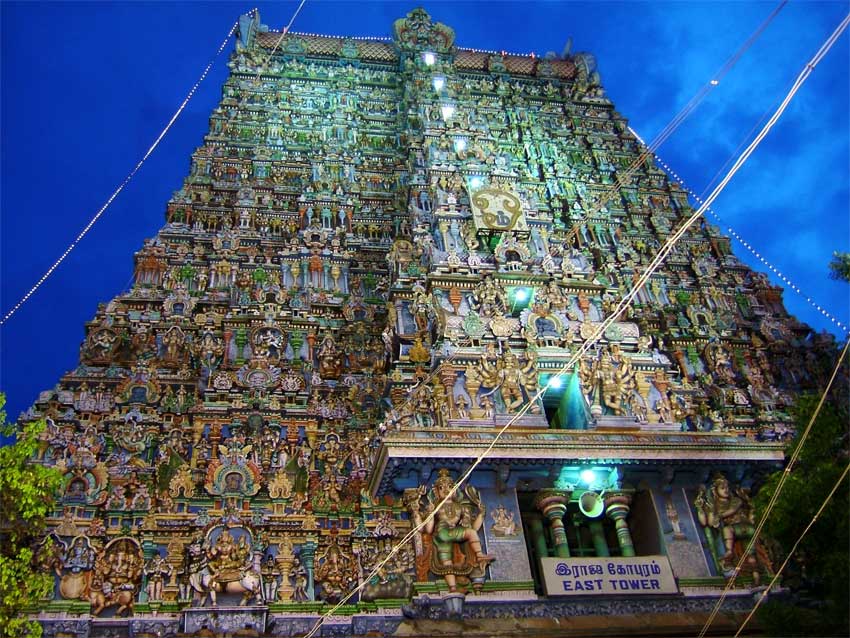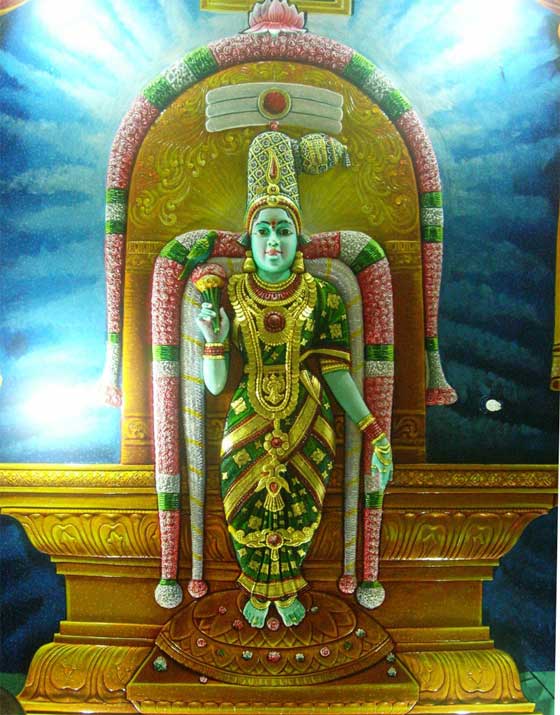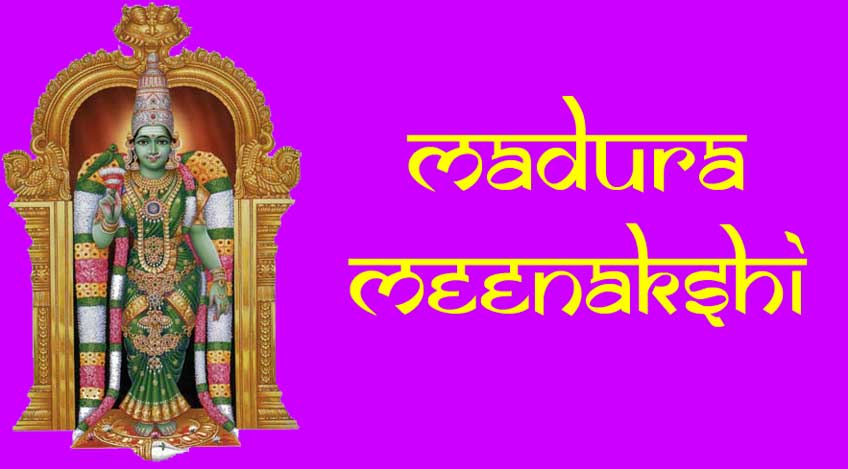
Meenakshi – the fish eyed-one. I had seen Her a long time ago when I was very young and I was anxious to see Her again. Who was she – this beauteous goddess around whose temple the huge bustling city of Madurai had grown? The origin of the temple dates back to Krita Yuga. Indra, the king of the gods was guilty of having killed his guru and was cursed to wander in the world as a beggar. He went to Kasi, Kanchi and Thirukadavoor and at last reached the forest of kadamba trees where he constructed a tower and installed a lingam and worshipped it for many years after which he was released from his curse. Much later Dhananjayan, a merchant living in the capital city of King Kulashekara Pandyan happened to see this lingam in the middle of the forest and informed the king whose capital was at Manavur at that time. The king went to the spot pointed out by the merchant and was entranced by the lingam. The Lord appeared to him king in a dream and told him to convert the forest into a city. The king did so and proceeded to build a proper temple round the lingam. During the final ceremony, the Lord allowed manna to drip from the crescent moon on his head and mix with the water which was being used for abhishekam (ceremonial bath). The water became very sweet and thus the town got the name Madurai (sweet) even though in ancient times the poets called it Alavai. Before he died Kulashekara Pandiyan crowned his son Malayathuvasan Pandiyan as king. Legend has it that the king – Malayathuvasan had no progeny and conducted a yaga (fire ceremony), for being blessed with a child. The king’s wife Kanchanamala was an ardent devotee of Parvathi, the consort of Shiva. In her previous birth she had begged the goddess who had appeared to her in a dream as an enchanting three year old, to be born as her daughter. Thus it was that at the end of the ceremony, Parvathi rose from the fire in the same form as a three year old girl and went and sat on the lap of the queen. The queen was blissfully happy. But the king was sad. He had hoped for a son and even though he felt that this child was divine, yet there was no doubt that it was a peculiar child. It was very beautiful with lovely fish-shaped eyes but it had a strange fishy smell and appeared to be having three breasts though of course they were not fully developed since she was only a child. Suddenly he heard a divine voice telling him to call the child Thadathagai and bring her up as if she were a boy. The voice also pronounced that her third breast would drop off and her fish smell disappear as soon as she met her husband. The king did as ordered and Thadathagai was brought up as his son and learnt all the martial skills which a young prince should learn. The king crowned her as his successor. The virgin queen now launched a series of attacks on all the neighbouring kings who thought they could easily defeat her since she was a woman. However the opposite was the case and she went right up to the Himalayas conquering all the countries in between and defeated all those who came to fight with her. At last she reached Kailas and routed all the Shiva ganas who were sent to fight with her. Hearing of the defeat of his army, Shiva himself entered the fray. The Lord stood before her draped in tiger-skin and adorned with ashes and snakes twined round his neck. The moment she saw him her third breast dropped off and she knew that he was the one meant to be her husband! The princess, who had been standing before him looking like a graceful tigress ready to pounce, threw down her weapons and stood shyly before him. He also recognized her as his divine consort, Parvathi and held out his hands to her. 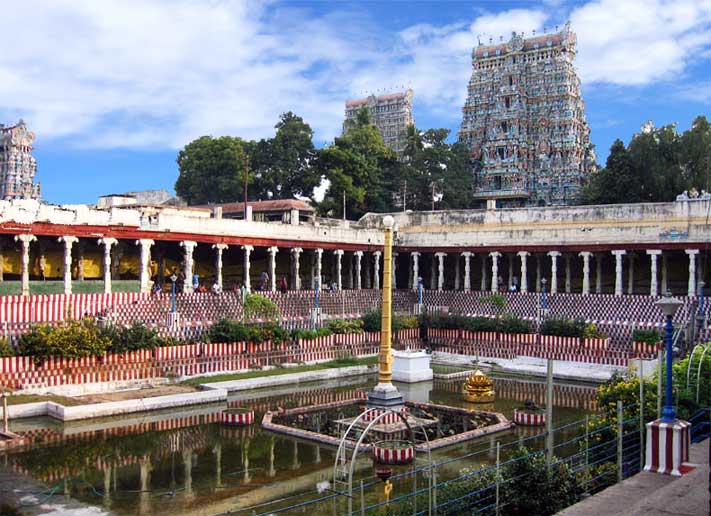 The Ashta siddhi Mandapam which was built much later has beautiful paintings of Meenakshi’s birth and crowning. The Lord ruled the state for some years under the name of Sundara Pandyan (the handsome Pandyan). During this time he is said to have performed many lilas or miracles which are known as “thruvilayadals” in Tamil. In order to please his wife’s desire for a child he caused his son Subramanyan to be born to him as his mortal son and called him Ugrapandian (the valorous Pandyan). After the coronation of the prince, the Lord and his consort Thadadhagai changed into their divine forms and entered the temples which had already been built for them and came to be known as Sundareswara and Meenakshi. The original temple was razed to the ground by the invading Muslim army but strangely enough the two shrines to Meenakshi and Sundaresan were spared. It was the Nayaks who were the successors to the Vijayanagar kings that brought about the amazing structure which we see today. Viswanatha Nayak of the Nayak dynasty – successor to the Vijayanagar Empire, commenced the task of reconstruction in 1510 CE, sticking meticulously to the original plan of the temple. It is believed to have taken over a hundred years to complete it. The temple itself is a celebration of art; it is believed to have over 30 million pieces of sculpture and stucco images and sprawls over a 14 acre temple complex. The present structure is one of the most impressive of all the south Indian temples. It has four striking towers facing the four directions which allow us to enter the temple complex. The temple tower on the North through which I entered is apparently the smallest but it is 160 feet and 6 inches. The South tower is the tallest at 170 feet and 6 inches. It has a thousand five hundred and eleven figures carved on it. Each figure is a marvel of sculpture. The Sundareswar temple is more ancient than the one for Meenakshi but it is a fact that now his consort Meenakshi holds the prominent place which is not very surprising since most of the states of India are being ruled by women! 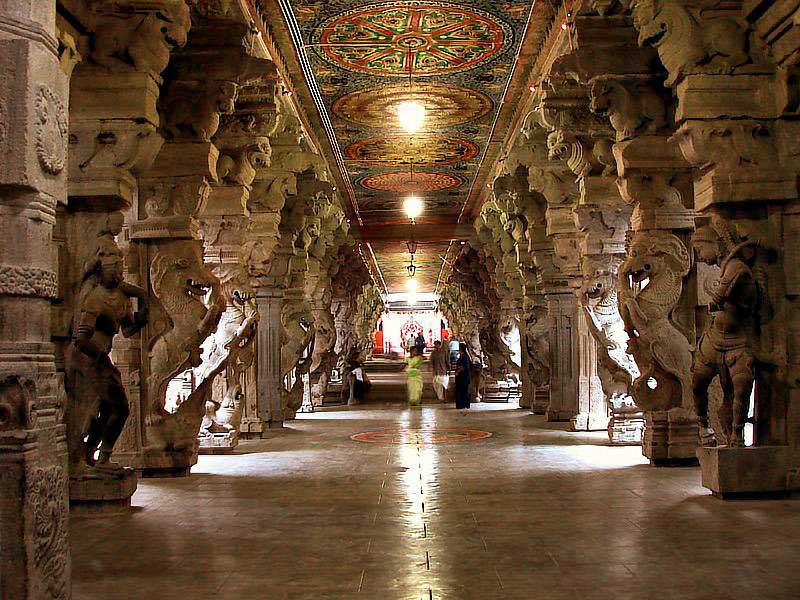 Madurai was the nucleus of the ancient Tamil Sangam (association of poets) and twenty four figures of the poets are to be seen even though there are said to have been eighty nine poets. Another striking figure was the scene of the Meenakshi Sundereswar wedding just in front of her entrance. The doorway to the inner parakrama (courtyard) is guarded by two handsome Dwarapalakas (guardians of the gate). As you go forward I was enthralled by the exquisite form of the fish-eyed goddess standing in all her beauty right in front of my eyes. I was carrying a lotus garland for her and someone asked me to go and give it to the priest standing at the side. I did so and he promptly went inside and came out with a big ball of sandal paste. I was quite shocked since I know that temples are not in the habit of doling out sandal paste so lavishly. I knew it was her way of way of welcoming me to her abode. The man who had taken me was also quite surprised. Since there were not too many people I was able to stand for a long time before her magnetic presence. When I could tear my gaze away from her enchanting form I saw that on my right was her marble bedroom. That night I had the privilege of attending the ceremony when her Lord, Sundaresan was brought with all pomp from his temple and both idols were placed on the swing inside the bedroom. There were hundreds of oil lamps and mantras chanted. I had a first hand seat much to my surprise since I wasn’t sure how I got there. In fact I had the good fortune of attending this particular puja on two out of my three days stay. One of the days was the eclipse of the moon and on that day the temple closed by 5 pm. Early morning at 5 am the same thing is repeated in the opposite way and the divine couple is woken up with songs and offered worship before being escorted to their own abodes. His servitors come with a palanquin to escort Lord Sundaresan back to his temple. Another figure which impressed me very much was the Mukkuruni Ganesha which is a huge figure which is right in front of us when we enter the Lord’s temple from the Meenakshi temple. On Vinayaka Chaturti day which is an important festival for Ganesha, this idol is offered a gigantic ball of rice made out of three kurunies equal to 18 measures. It has to be carried by eight people, in a huge pot slung on two poles. Hence he is called Mukkuruni Ganesha. This idol was found by the king Tirumulai Nayakar when he was digging a tank three kilometers away from the place. 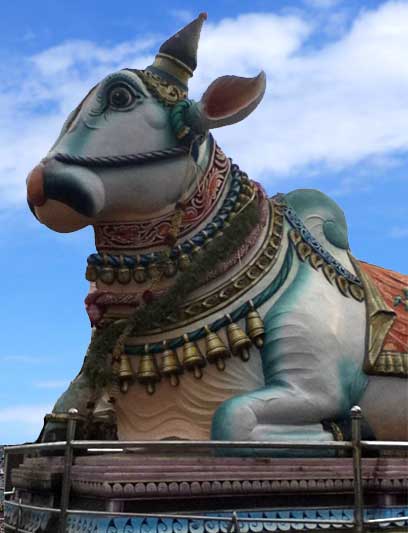 Some fantastic pieces of sculpture are to be seen in the outer parakrama (courtyard) in the Sundareswara temple. Just in front is the Nandi Mandapam. Every temple of Shiva will have a Nandi in front since he is the guardian of Shiva’s abode and none can enter without his permission. The eight blackstone pillars behind Nandi are really masterpieces. The postures which attracted me most were the two commanding figures of Agni Veerabadra and Agora Veerabadra. The force and terror emanating from these two ferocious avataras of Shiva was really thrilling. Another two remarkable pillars on the northern side depicted the famous dance of Shiva known as Oortha Tandavar, and another of Badrakali. Oortha Tandavar depicts Shiva in an incredible pose with his right foot raised straight up to reach his ear! It is said that once Shiva and Parvathi competed with each other to see who the better dancer was. Both of them were remarkably well matched. At last Shiva beat her by doing this most difficult pose called the Oortha Tadava, which she could not repeat! 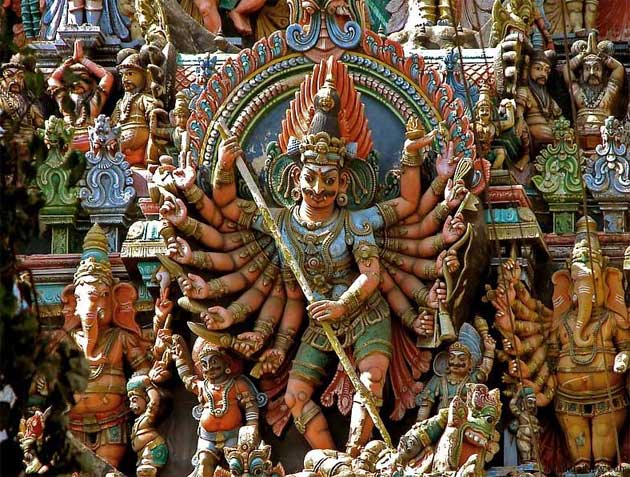 There is a beautiful idol of Lakshmi in the same parakrama. When you enter the inner parakrama the first thing you notice is the hall called the Velli Ambalam (silver temple). Here there is a beautiful figure of Nataraja similar to the one in Chidambaram. The one in Chidambaram is covered with gold leaf and this one in silver leaf. Another feature of this Nataraja is that he is lifting up his right leg and hand unlike in the normal Nataraja pose in which he lifts up his left hand and leg. The form of Sundaramurti in the sanctum sanctorum is that of a lingam which is his formless form. As mentioned before the Lord is said to have performed many miracles which have been compiled under the name of the “Thiruvilayadals” or divine plays of the Lord. 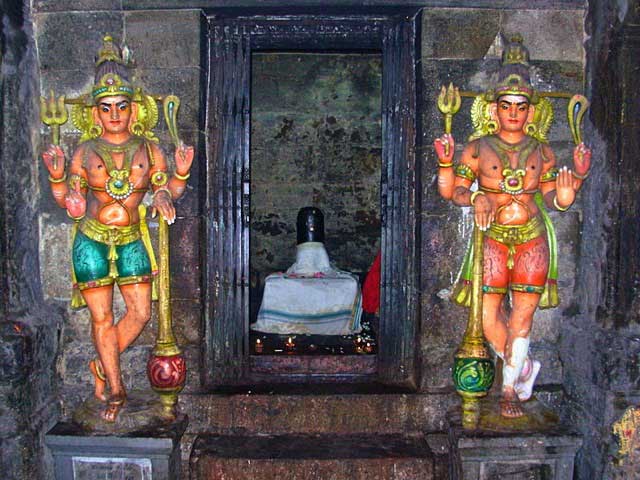 I normally like to go for the opening puja in any temple. I was told that the temple would open at 4.30 am. The first morning I ran through the deserted streets at 4.30 am and found the massive front door still closed. The police guard looked suspiciously at me and said I would have to wait till it was opened. At last it was opened and I ran in. I was rather surprised to see that people were already waiting before the inner courtyard. I suspected that there must be other entrances. One man extracted hundred rupees from and allowed me to get into the closed enclosure. I don’t think it did much good since I would have been able to get in anyway as the doors opened. As mentioned above it was quite thrilling to see the opening of the conjugal chamber with many chants and waving of lights and the couple going back to their own temples. Many things appeared to be going on at the same time and I was at a loss to know how to proceed. I ran thither and thither and felt that I must have missed out on some good points. I noticed many ladies who had come the previous night for the final puja and felt instinctively that they were locals who must be coming daily. The next morning I didn’t go out till quarter to five and suddenly heard pattering footsteps behind me. There was not a soul in sight and when I glanced back I saw that one of the ladies I had noticed the previous day was rapidly advancing on me. She smiled at me as she passed and I smiled and scurried after her. She was young and a fast walker but I panted after her to the best of my ability feeling very much like Alice running after the white rabbit. Since she was suffering from Lukederma she did indeed resemble a white rabbit. She knew exactly where to go and what to do. I felt that she had been sent by Meenakshi to guide me. She took me to all the different rituals which were being held in the morning between 5 and 6 am. She had no time to speak since she was so busy running and lighting lamps in many places. She carried a little basket with lamps and ghee and wicks so she didn’t have to buy the ones which were being sold at an exorbitant price inside the temple. However she was kind enough to look back now and again to make sure that I was following her. I was truly grateful to her and thanked the goddess who had sent her to me. After six o’clock she said good bye and I was left to my own devices. The rest of the day I spent in going
to the two great Muruga temples
which were part of the aaruveedu which has been described in the
article on Thiruchandur.
I was really sad to leave the
presence of this enchanting personality
of Meenakshi. I felt her presence with me all the time. Just as I was
leaving I realized that I had not even got a photo of hers. I don’t
really like to keep large photos of all deities but I always get at
least a small photo. As I was waiting for the car to take me to the
station, there came my saviour of the previous day carrying an enormous
photo of the divine mother of Madurai! My eyes filled with tears when I
saw it and I knew that it had come straight from Madura Meenakshi
(sweet Meenakshi) with love!
Hari Aum
Tat Sat |
|||||||
|
